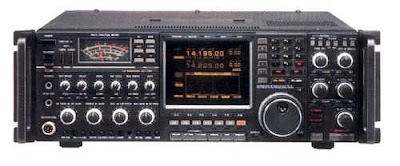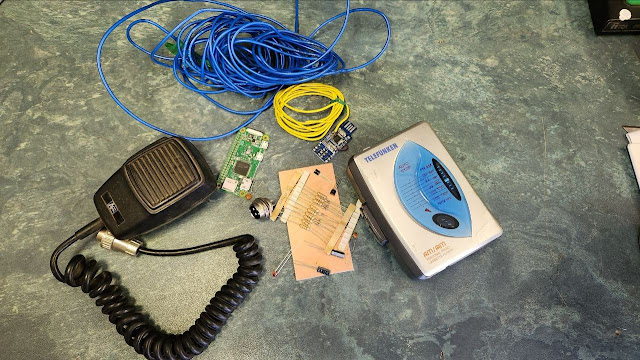A while ago a few images of a Homebrew Frequency Counter were placed on the Amateur Radio 101 Telegram Group by Curtis ZS6CMO. I asked Curtis to provide more information on the build and he obliged. Before I publish more info on the build I decided to provide the basics of a frequency counter:
What is an RF frequency counter: basics
In essence a frequency counter is an electronics test instrument that operates by counting the number of times a signal passes a give voltage point - trigger point - in a given time.
Some frequency counters will have trigger points that can be set, but most automatically set the trigger - often around the zero crossing point.
To illustrate the operation, if the time for which the frequency counter is set to count is a second, i.e. a gate time of a second, and the waveform crosses the trigger point a hundred times, there will be a hundred repetitions of the waveform in a second, i.e. its frequency is 100 Hertz.
If the same waveform was used, but the gate time is reduced to a tenth of a second, then only ten repetitions would be seen. The circuitry can easily accommodate this and the circuit can deduce that in a tenth of a second ten repetitions are seen, then the waveform has a frequency of 100 Hz.
There is a balance between getting an accurate count and the length of time of the gate. With a tenth of a second gate time and a 100Hz signal, only ten crossings will be counted, whereas with a gate time of a second 100 crossings will be counted. Dependent upon where the gate time falls with respect to the incoming signal, it can be seen that the longer gate time will be more accurate.
The issue with the longer gate time is that the update rate is not as fast, but in many situations this may not be an issue.
The length of the gate time is critical. Normally the signal for the gate is taken from a crystal controlled oscillator of some form to ensure an accurate time. Often TCXOs (temperature controlled crystal oscillators), or OCXOs (oven controlled crystal oscillators) are used to ensure the best accuracy.
Another issue with these frequency counters can be that noise on the signal will cause false counts to be registered. Often careful design of the input circuitry can help ensure that these false counts only rarely occur.
RF frequency counter applications
RF frequency counters are used in very many applications where the frequencies of radio frequency or even audio frequency signals are to be measured. Some applications may include:
1. Measuring the frequency of a transmitter carrier.
2. Measuring the frequency of an oscillator in a circuit.
3. Measure the frequency of a signal on a line
4. Any application where the frequency of a steady repetitive signal needs to be measured.
To be able to measure the frequency of an RF signal using a frequency counter there are a few prerequisites.
1. Frequency must be steady, i.e. not varying.
2. The signal should not have modulation applied as this will prevent proper counting.
3. Signal must have sufficient amplitude – typically signals over about half a volt are suitable.
4. Signals should not be so large that they overload the input - check the manufacturer’s specification if in doubt.
Types of frequency counters
Although frequency counters may appear to be very straightforward, there are several different types. Each one is applicable to its own situation and capable of providing very good service.
Bench frequency counter: The bench frequency counter is the most commonly used format for this type of electronics test equipment.
PXI frequency counter : Along with many other items of test equipment, it is possible to obtain frequency counters in a PXI format. The PXI system provides a rack system for test and control systems. Test instruments in the form of a PXI card, and int his case a PXI frequency counter or timer can be slotted into the PXI rack. In this way a PXI frequency counter could be part of a sophisticated overall test system.
Handheld frequency counter: Frequency counter technology does not need to be large and several handheld frequency counters are available.
Frequency counter in a digital multimeter: Some digital multimeters incorporate a frequency counter function. When included in a DMM, normally it will be relatively basic. Typically no coaxial RF connection is available and this will mean that the test probes will need to be used and this may result in stray pick up and false count triggers which will make the reading less accurate. Additionally there will not be an accurate time base within the DMM, and this will also mean that results are not particularly accurate. That said, they will be more than adequate for many readings, especially when fault finding, or generally wanting to look at general readings of frequency.
Panel meter: Frequency counters and timers are available in panel mount modules. These can be incorporated into larger items of equipment where they can be used for counting frequency or time intervals. These frequency counter timers can be obtained relatively cheaply.
Whatever the actual format of the PXI frequency counter, the same basic techniques are used, and the frequency counter timer will operate in basically the same way.
RF frequency counters are a widely used piece of electronics test instrumentation. They are used for many RF measurements. Although Spectrum analyzers are also able to make frequency measurements, and todays analyzers can take very accurate readings, RF frequency counters are relatively cheap and provide measurements that are equally accurate or more accurate. They are widely used as bench test equipment.
Counter timers are also widely used test instruments, used for measuring intervals, and they can be used for very accurate measurements.
The above was just a short explanation on how a Frequency Counter works.
Herewith more information about the 1 - 500 Mhz Frequency Counter Project build by Curtis ZS1CMO.
1 - 500 Mhz Frequency Counter Project build by Curtis ZS1CMO (PDF)
LCD FREQUENCY COUNTER WITH EEPROM FUNCTION - Osmo OH6CJ
Images (Click on images for larger view.)




















































